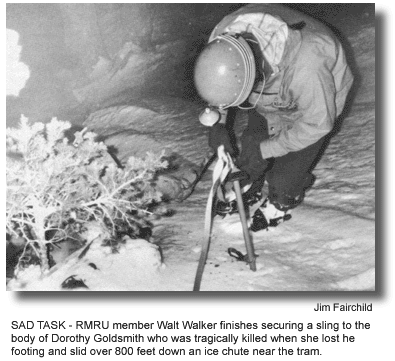Woman slid 800 feet down ice chute
|
December 4, 1982 |
 |
By Walt Walker
Saturday had begun very early (5 to 6 a.m.) for most RMRU members. It had been necessary to arise while it was still dark so we could be out to Desert Hot Springs by 8 a.m. Shortly after 8 a.m. we began our annual Helitac training at Don Landells heliport. We finished training about 1:30 p.m., broke for lunch, then began our annual van clean-up and inventory of equipment. It was after dark when I left Desert Hot Springs.
When I arrived home I jumped in the shower to remove the dust and dirt that had accumulated during training. During dinner I told my wife, Sondra, about the days events, especially our practicing aerial pickups using long sling ropes. We turned on the TV and started to watch a movie, when the phone rang. You guessed it, an urgent call for RMRU, from the Banning Station of the Riverside County Sheriff's Department. My son Kevin, picked up the No. 1 RMRU van, stopped by my residence and picked me up. We arrived at the lower terminal of the Palm Springs Aerial Tramway at 11:45 p.m.
The captain of the Banning station, Ray Canova, was there waiting for us. He advised us that a 23 year old woman had slipped, fallen, and slid out of sight down one of the ice chutes near the top of the tram. he also, advised us that the Mt. San Jacinto Wilderness State Park Rangers were descending the chute in search of the young woman.
In less than an hour we had packed our own packs, assembled a tram car load of RMRU equipment, rode to the top of the tram and started over to the top of the chute where the young woman had fallen. We were met by some of the state park rangers and they told us that some of their people had descended about 200 feet and had not located anything, except for one after ski boot.
While Jim Fairchild and I prepared to descend, Kevin Walker, Mel Krug, John Dew, Joe Erickson, Mark Hebert, Cameron Robbins, Ed Hill and Randy Iwasiuk started setting up anchors for the descent. Mary Bowman was in the upper station of the tram, along with Sgt. Dave Weekly. Mary had to run base out of her pack that night.
We of RMRU have a natural positive attitude and I was hoping to find Dorothy Goldsmith less than 300 feet down and only slightly injured. I swung on a heavy pack, clipped into the rappel rope, switched on RMRU's portable spotlight and began my rappel in the darkness of the chute. When I got to the end of the 300 foot rope I used the light to look down-ward for disturbances in the snow, nothing! I set up another 300 foot rope and started down again. Jim started down on the rope I had just gotten off of.
Approximately 500 feet down I located a sock and an after ski boot that matched the one found above. Descending further I found some marks in the snow. just before I had descended the complete length of a third 300 foot rope, I found the young woman. You did not have to be a doctor to observe that she had died sometime during her 900 foot fall. With a heavy heart I radioed, by code words, that I had located the body.
 It was decided that Bernie McIlvoy
would descend also, and in the morning he would
help Jim and I move the body to a small clearing
in the trees on the very steep slope. Shortly
before 7 a.m. Mary radioed that Don Landells
would be coming in with a cargo sling attached to
a sling rope that would be connected to the
bottom of the Jet Ranger Helicopter.
It was decided that Bernie McIlvoy
would descend also, and in the morning he would
help Jim and I move the body to a small clearing
in the trees on the very steep slope. Shortly
before 7 a.m. Mary radioed that Don Landells
would be coming in with a cargo sling attached to
a sling rope that would be connected to the
bottom of the Jet Ranger Helicopter.
It was hard to get moving after sitting for better than two hours during the wait for morning light. We placed the subject in the body bag, secured a rope to it, and while Jim lowered the rope, Bernie and I descended with the body.
In a very short time we could hear the helicopter coming up the canyon. When Don came into sight, we signaled to him. He hovered over us and we disconnected the cargo sling from the 100 foot sling rope. Don applied power and flew a short distance away. Both to make it easier for us to hear and more importantly, to not have a blast of cold air blown onto us from the main rotor blades. As quickly as possible we loaded the body into the cargo net and radioed for Don to return. Once again he was hovering over us, we connected the cargo sling to the sling rope, gave the up hand signal and Don flew back to the lower tram parking lot. A sadness overcame me as I attached my Jumars to the rope for the ascent up the steep chute. We had not been able to be a 'rescue' team in the sense I, and others, like to think of.